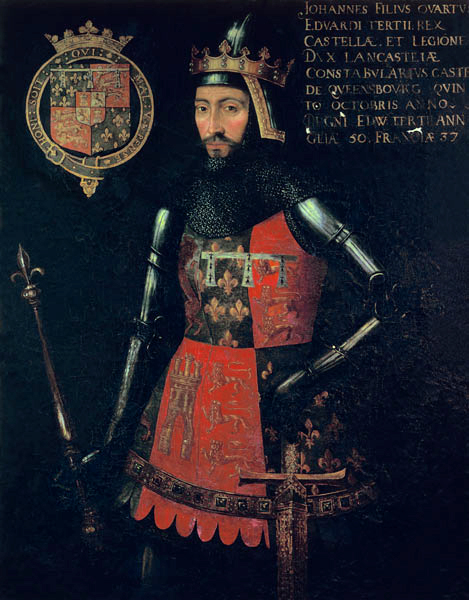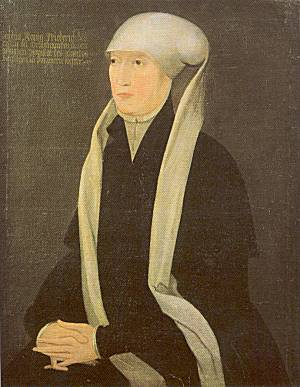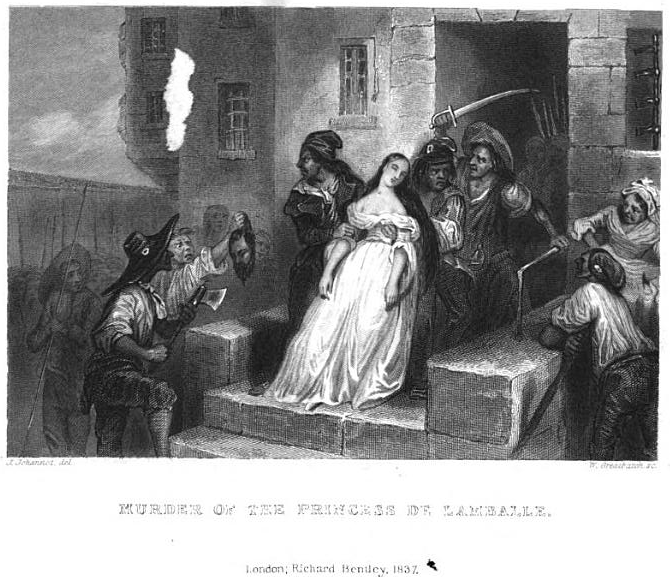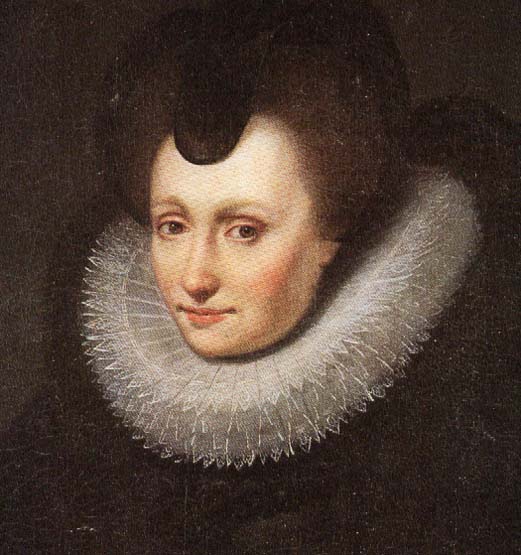by Susan Flantzer
© Unofficial Royalty 2021

Catherine of Lancaster, Queen of Castile; Credit – www.findagrave.com
Born March 31, 1373, at Hertford Castle in Hertfordshire, England, Catherine of Lancaster was the elder but the only surviving child of the two children of John of Gaunt, Duke of Lancaster and his second wife Constance of Castile. Catherine’s paternal grandparents were King Edward III of England and Philippa of Hainault. Her maternal grandparents were King Pedro I of Castile and his first wife Maria de Padilla. Catherine was a half-sister of King Henry IV of England.
Catherine had one younger brother who died in infancy:
- John of Lancaster (1374 – 1375)
Catherine had seven half-siblings from her father’s first marriage to Blanche of Lancaster:
- Philippa of Lancaster (1360 – 1415), married King João I of Portugal, had issue
- John (c.1362/1364), died in infancy
- Elizabeth of Lancaster (1364 – 1426), married (1) John Hastings, 3rd Earl of Pembroke (2) John Holland, 1st Duke of Exeter, had issue (3) John Cornwall, 1st Baron Fanhope, had issue
- Edward of Lancaster (born and died 1365)
- John of Lancaster (born and died 1366), died in early infancy
- King Henry IV of England (1367 – 1413), married (1) Mary de Bohun, had issue including King Henry V of England (2) Joanna of Navarre, no issue
- Isabella of Lancaster (born 1368), died young
Catherine had four half-siblings from her father’s relationship with his mistress and subsequently his third wife Katherine Swynford:
- John Beaufort, 1st Earl of Somerset (1373–1410), married Margaret Holland, had issue, great-great-grandparents of King Henry VII
- Henry, Cardinal Beaufort, Bishop of Winchester (1375–1447), unmarried
- Thomas Beaufort, Duke of Exeter (1377–1426), married Margaret Neville of Horneby, no surviving issue
- Joan Beaufort, Countess of Westmorland (1379–1440), married (1) Robert Ferrers, 5th Baron Boteler of Wem, had issue, ancestors of many notable persons including Queen Elizabeth the Queen Mother; Diana, Princess of Wales; Catherine, Duchess of Cambridge; George Washington, etc. (2) Ralph de Neville, 1st Earl of Westmorland, had 14 children, grandparents of King Edward IV and King Richard III
Catherine’s parents had married in 1371, as part of a calculated plan for the English to gain control of the Kingdom of Castile, now part of Spain. In 1369, King Pedro I of Castile had been killed by his half-brother who then assumed the throne of Castile as King Enrique II of Castile. Catherine’s mother Constance was the elder surviving daughter, the co-heiress of her father with her younger sister Isabella, and a claimant to the throne of Castile. After his marriage to Constance, John of Gaunt assumed the style of King of Castile in the right of his wife. Constance’s younger sister Isabella of Castile accompanied her sister to England. In 1372, Isabella married John of Gaunt’s younger brother, Edmund of Langley, 1st Duke of York as part of a dynastic alliance to further the English claim to the crown of Castile.
The English were never able to gain control of the Kingdom of Castile. In 1388, under the Treaty of Bayonne, Constance, Duchess of Lancaster renounced all claims to the Castilian throne and accepted the proposal of her first cousin King Juan I of Castile, to marry her daughter Catherine to his son, the future King Enrique III of Castile. The marriage would end the conflict between the descendants of Pedro I of Castile and Enrique II of Castile and give legitimacy to the House of Trastámara which would become the first ruling house of a united Kingdom of Spain.

Enrique III, King of Castile; Credit – Wikipedia
On September 17, 1388, at the Cathedral of Saint Antoninus of Pamiers in Palencia, Kingdom of Castile, now in Spain, fifteen-year-old Catherine of Lancaster was married to her nine-year-old second cousin Enrique, who received the title Prince of Asturias at that time. He was the first person to hold this title, and it designated him as the heir apparent. Today Prince or Princess of Asturias is the title used by the heir apparent or heir presumptive to the throne of Spain.
It is probable that the marriage was not consummated for some time due to Enrique’s young age. Eventually, Catherine (Catalina in Spanish) and Enrique had three children:
- Maria of Castile (1401 – 1458), married Alfonso V, King of Aragon and Naples, no children
- Catalina of Castile (1403 – 1439), married Infante Enrique of Aragon, Duke of Villena, no children
- Juan II, King of Castile (1405–1454), married Maria of Aragon, had four children but only Enrique IV, King of Castile survived childhood.
Through their son Juan II of Castile, Catherine and Enrique III are the grandparents of Isabella I, Queen of Castile and great-grandparents of Catherine of Aragon (daughter of Isabella I of Castile and Ferdinand II of Aragon), the first wife of King Henry VIII of England. Catherine of Aragon was named for her great-grandmother Catherine of Lancaster, Queen of Castile. Catherine and Enrique are the ancestors of all subsequent monarchs of the Kingdom of Castile and a united Kingdom of Spain.
On October 9, 1390, Catherine’s father-in-law King Juan I of Castile, aged thirty-two, died after a fall from his horse and her eleven-year-old husband became Enrique III, King of Castile. After a three-year regency, King Enrique III assumed full power. However, due to ill health in the latter part of his reign, Enrique delegated some of his power to his brother Ferdinand. Enrique died, aged 27, on December 25, 1406, in Toledo, Kingdom of Castile, now in Spain. King Enrique III’s son and successor was not quite two years old when he became King Juan II of Castile. His mother Catherine and his paternal uncle Ferdinand, who became King Ferdinand I of Aragon in 1412, were co-regents during his minority. When Ferdinand died in 1416, Catherine served as sole regent until her death in 1418. Her son King Juan II immediately took power, without continuing the regency.

Chapel of the New Monarchs at Toledo Cathedral where Catherine I buried with her husband along with other members of the the House of Trastámara; Credit – De Jose Luis Filpo Cabana – Trabajo propio, CC BY 3.0, https://commons.wikimedia.org/w/index.php?curid=30738992
On June 2, 1418, Catherine of Lancaster, Queen of Castile died from a stroke at age 45 in Valladolid, Kingdom of Castile, now in Spain. She is buried with her husband King Enrique III of Castile in the Capilla de los Reyes Nuevos (Chapel of the New Monarchs) in the Primate Cathedral of Saint Mary of Toledo, also known as Toledo Cathedral in Toldeo, Kingdom of Castile, now in Spain.

Tomb of Catherine of Lancaster, Queen of Castile; Credit – De Borjaanimal – Trabajo propio, CC BY-SA 4.0, https://commons.wikimedia.org/w/index.php?curid=44532496
Works Cited
- En.wikipedia.org. 2021. Catherine of Lancaster – Wikipedia. [online] Available at: <https://en.wikipedia.org/wiki/Catherine_of_Lancaster> [Accessed 2 April 2021].
- En.wikipedia.org. 2021. Henry III of Castile – Wikipedia. [online] Available at: <https://en.wikipedia.org/wiki/Henry_III_of_Castile> [Accessed 2 April 2021].
- Es.wikipedia.org. 2021. Catalina de Lancaster – Wikipedia, la enciclopedia libre. [online] Available at: <https://es.wikipedia.org/wiki/Catalina_de_Lancaster> [Accessed 2 April 2021].
- Flantzer, Susan, 2021. Constance of Castile, Duchess of Lancaster. [online] Unofficial Royalty. Available at: <https://www.unofficialroyalty.com/constance-of-castile-duchess-of-lancaster/> [Accessed 2 April 2021].
- Flantzer, Susan, 2017. John of Gaunt, 1st Duke of Lancaster. [online] Unofficial Royalty. Available at: <https://www.unofficialroyalty.com/john-of-gaunt-1st-duke-of-lancaster/> [Accessed 2 April 2021].
This article is the intellectual property of Unofficial Royalty and is NOT TO BE COPIED, EDITED, OR POSTED IN ANY FORM ON ANOTHER WEBSITE under any circumstances. It is permissible to use a link that directs to Unofficial Royalty.

























